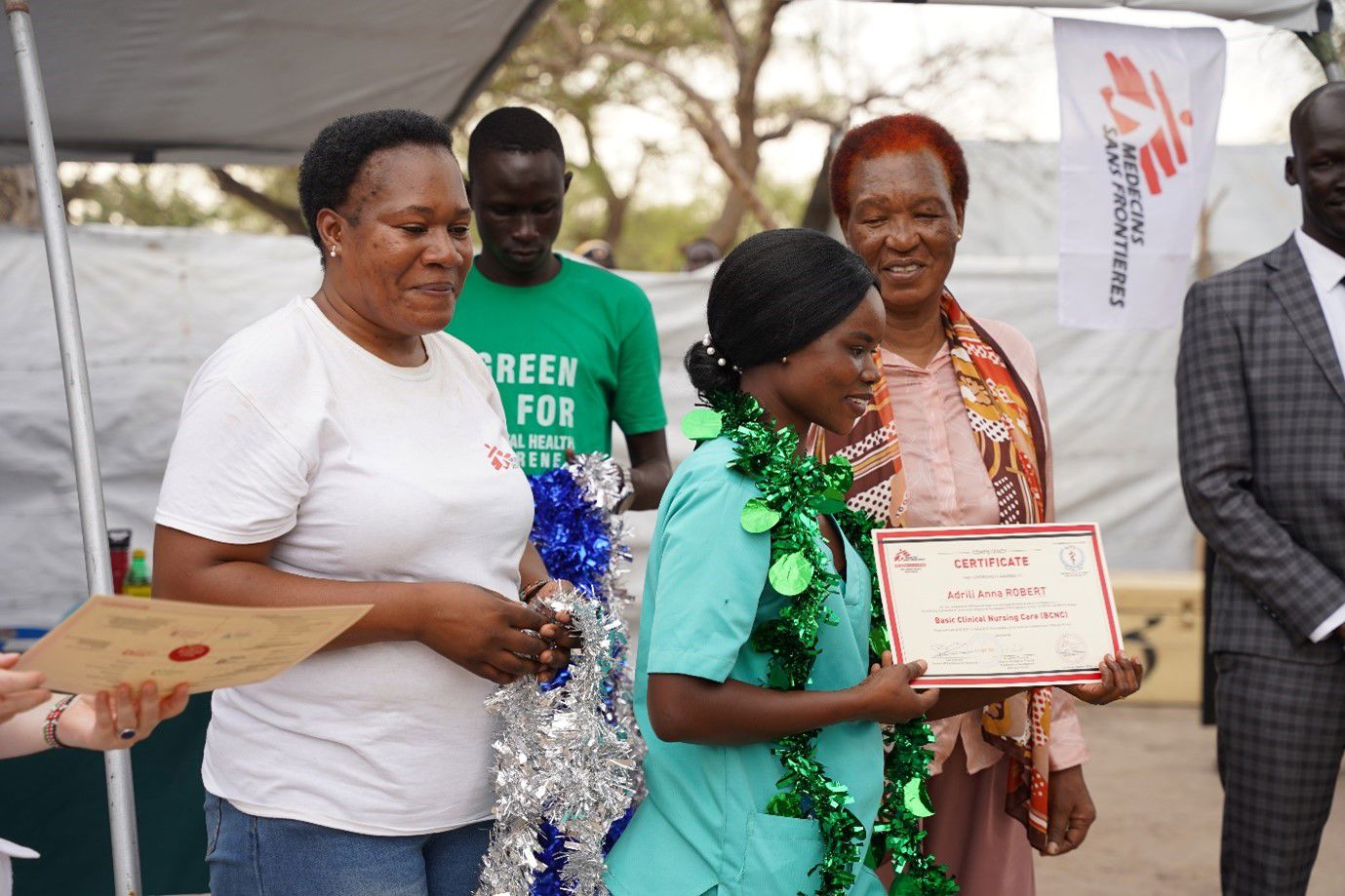Performing surgery on a newborn baby is always considered a high-risk procedure, regardless of the location. This is primarily because for neonates, their physiological system is rather unique, their recovery and immune function are not yet fully developed, and they require intensive care before and after the surgery. In underdeveloped regions, such kind of operations pose even greater challenges and are seen as a daunting task.
In South Sudan, health services for newborns, including intensive care and surgery, are especially limited.
Our MSF hospital in Bentiu recently admitted a two-month-old baby boy who had been suffering from continued vomiting for four to five days. Colleagues in the ER sent him to the pediatric ward for treatment.
After examining the baby, our American paediatrician noticed that something was amiss and urgently asked me to go to help.
Similar to most South Sudanese infants that we had encountered, this baby was malnourished and underdeveloped. He weighed only about five kilograms! He wasn't exactly "skin and bones" and looked just like a typical newborn in Hong Kong, despite his more slender limbs. However, what concerned me the most was his prominently swollen abdomen! The swell was unusually, and although there were no signs of acute peritonitis, there was a severe intestinal obstruction as a significant amount of bile and gastric juice was found in his nasogastric tube.
The anaesthetist and I furrowed our brows because both of us were aware of the high risks associated with performing such surgery on this baby. Firstly, administering anesthesia would be challenging due to the limited availability of equipment, with only one or two endotracheal tubes remaining for intubation.
Secondly, postoperative care was another concern. Despite our hospital being one of the few in South Sudan that was equipped to offer surgical services, we lacked an "intensive care unit", not to mention the one specific for neonates. After the surgery, the baby would be transferred back to a general ward with around twenty beds. There would only be two to three nurses working in each shift, which was insufficient for proper care for such patients.
On top of that, various challenges and complications could arise in the surgery. Some congenital diseases cannot be resolved with a single operation, and we just could not perform surgery for some kind of pathologies in this relatively basic operating theatre. Furthermore, as I am not a pediatric surgeon, I could only improvise to address any unforeseen circumstances.
Our team of an anaesthetist, a paediatrician, and myself, a surgeon, deliberated at length. If we chose not to operate, we knew that the baby's condition would only worsen, eventually leading to death.
Someone proposed whether we should observe the situation for a day or two before proceeding with the surgery. However, considering the boy’s condition - he was having a fever, a rapid heartbeat, and a severe intestinal obstruction that couldn't be easily cured with conservative therapy alone - I believed that early treatment was crucial. We must remember that a baby's body is fragile, and any delay would only worsen his condition, making it more challenging to perform surgery later.
After reaching a consensus, we gave an account for the benefits and drawbacks of the surgery to the patient's parents, including the risks involved and the difficulties of postoperative care. They understood and agreed with doing it.
The surgery would begin in an hour! The anaesthetist and I were veterans in the field, yet we both told each other that we had to prepare a bit. The anaesthetist checked the anesthesia equipment and medications in the operating theatre, ensuring everything was ready. In the meantime, I quickly went through my “holy book” on battlefield surgery, reading about various pediatric pathologies and their treatments, and rehearsing different scenarios in my head.
Time flew by, and the moment of surgery arrived. Everyone in the operating theatre wastense. We turned off the air conditioner to make the room warmer, reducing the risk of complications caused by loss of body heat for the baby. Each member of the surgical team then reported on the potential difficulties in the surgery, trying to minimise errors and shorten the operation time.
The patient was carefully positioned on the operating table, and the surgery commenced.
The anaesthetist and nurses meticulously connected the monitoring equipment, administered oxygen and medications to the baby boy, and intubated him for a general anaesthetic.
Then it was my turn. I cautiously picked up the surgical knife and cut open the swollen belly, revealing the disproportionately dilated small intestine. I thoroughly examined the entire abdominal cavity and discovered that the baby had intussusception in his small intestine.
Intussusception is a common cause of pediatric intestinal obstruction, where a portion of the intestine folds like a monocular, with one segment slipping inside another segment. One of the causes would be the swelling of lymph nodes due to gastroenteritis. In severe cases, it can lead to intestinal ischemia, necrosis as well as perforation, thus increasing the risk of death.
Unfortunately, the boy’s trapped small intestine had already experienced ischemic necrosis and perforation, explaining his symptoms of high fever and rapid heartbeat. This was luckily not a complex surgery, and the infected segment of the small intestine was successfully removed.
I immediately performed a local resection to remove a small part of the small instestine, then reconnected the two ends. The surgery took approximately an hour to complete. The baby boy remained in a stable condition and was later transferred to the ward for observation after waking up from anesthesia.
At that moment, our entire team felt a deep sense of relief and gratitude. By not delaying the surgery, we prevented the necrotic and perforated intestine from further deterioration and causing death. Achieving a successful surgery in such resource-limited settings was no easy feat.
We could eventually have a good night’s sleep.
Early the next morning, I went to check on the baby’s condition. The paediatrician told me that the boy was still having a mild fever, but his other vital signs, including heart rate, had improved. He was generally in a stable condition and his abdominal distension had also subsided. The boy’s mother, who was holding the baby in her arms, showed a sense of relief as well.
We thought we had defeated death this time, but unfortunately, life had other plans.
Around noon, the baby's mother suddenly alerted the nurse that something was wrong. My colleagues and I rushed over, only to find that the baby’s breathing and heartbeat had stopped for more than 15 minutes. It was too late to resuscitate him. He had passed away. His mother was devastated, and tears filled the room. We stood there, helplessly watching his seemingly calm departure.
Due to the lack of equipment, we couldn't determine the exact cause of the sudden deterioration. Possibilities included disrupted physiological system or electrolyte disorders resulting from intestinal obstruction, aspiration pneumonia caused by preoperative vomiting and so on.
Everyone in the surgical team felt sad, frustrated, regretful, and a slight sense of helplessness with the news.
We had hoped that by timely treating the condition, this baby would have a chance to live. We introspected but realised that we had done our best within the constraints of our resources. In a developed country with advanced postoperative care and equipment, perhaps the outcome could have been different.
As they say, things in life are impermanent. At this moment, in a country with limited medical resources, diseases and death seem to be the actual “permanence”.



